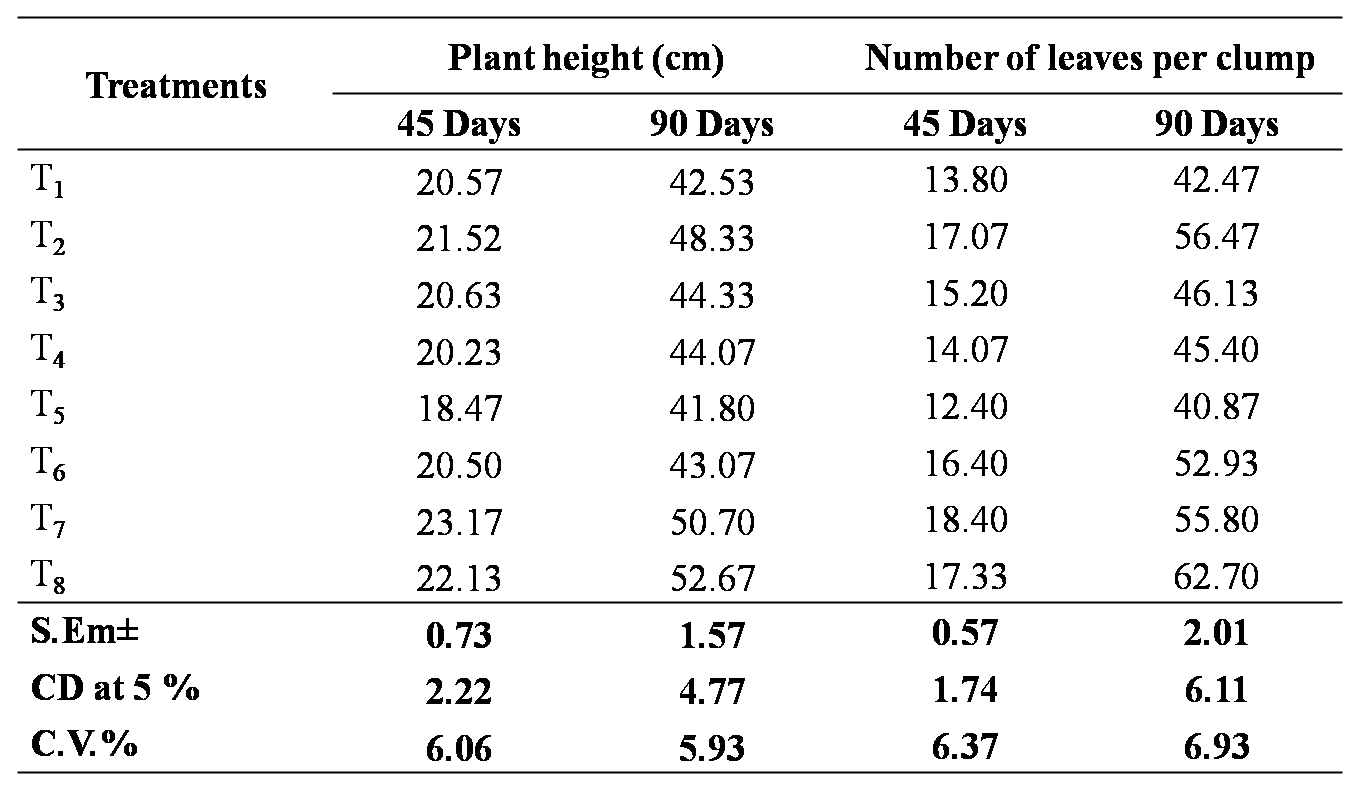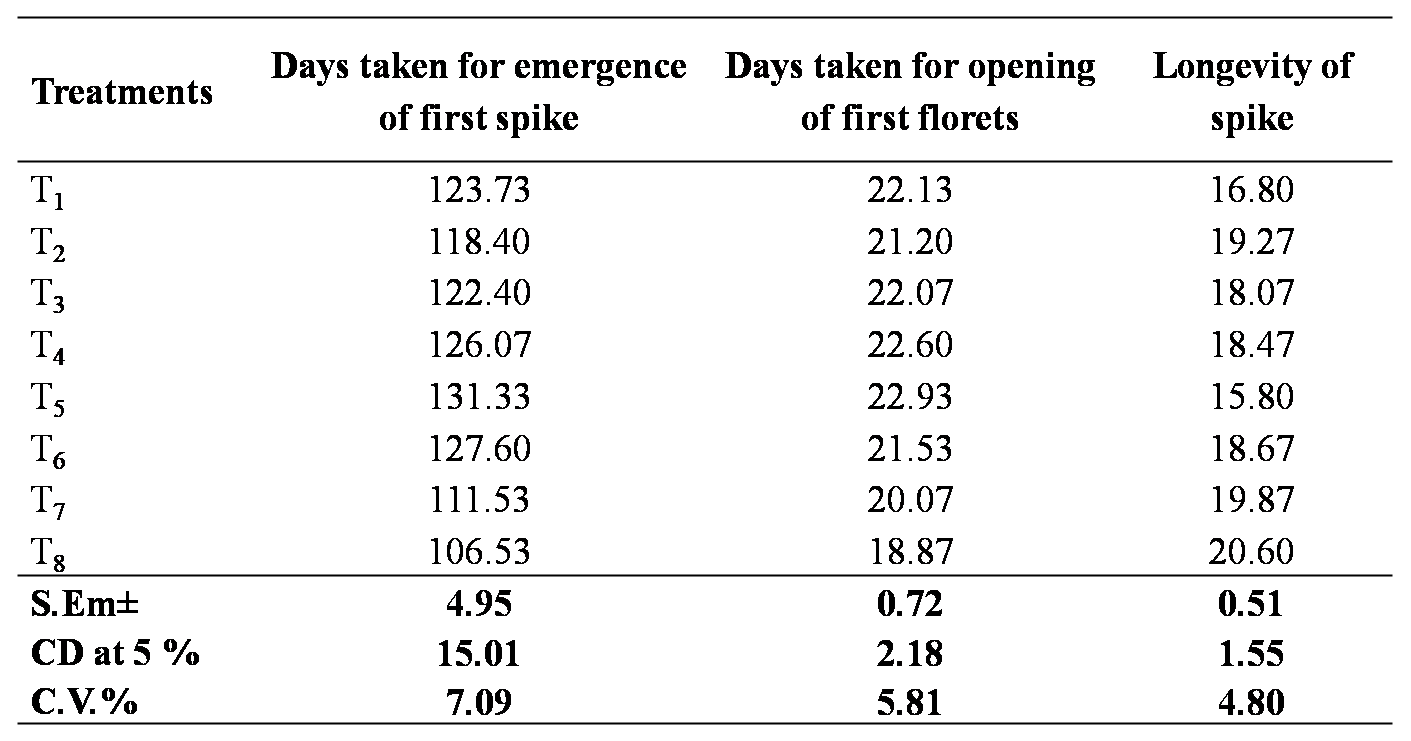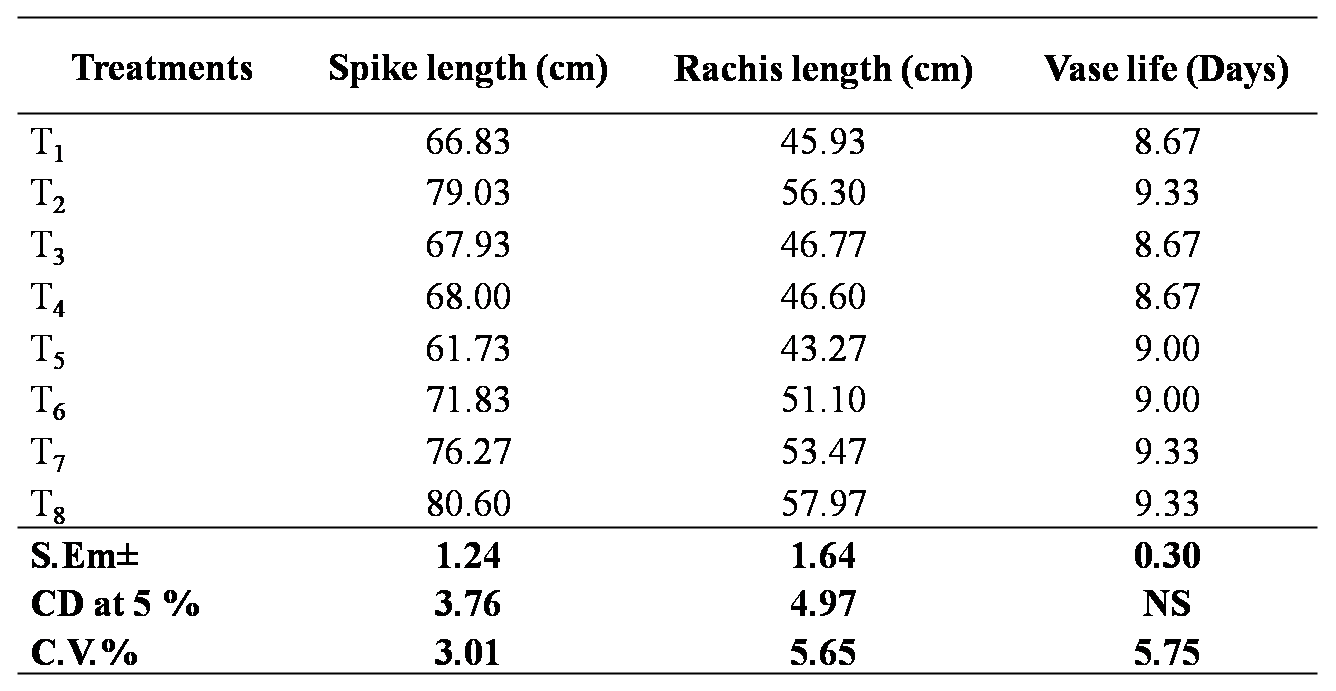Abstract
An experiment was conducted at College of Horticulture, SDAU, Jagudan (Gujarat) during the period of April, 2022 to February, 2023. The experiment included eight treatments viz. no mulch, black polythene, silver-black polythene, red-black polythene, mustard straw, castor shell, fennel straw and bishop’s seed straw. The experiment was laid out in a Randomized Block Design and each treatment was replicated three times. The treatments were evaluated based on growth, yield and quality of tuberose. All the types of mulches, whether inorganic or organic, performed better than bare soil. The plots treated with bishop’s seed straw mulch recorded maximum growth parameters and highest yield with better quality followed by fennel straw and black polythene mulch. No mulch recorded lowest value in all parameters during the investigation.
Introduction
Tuberose (Polianthes tuberosa L.) is an important flower crop grown in India mainly for its beautiful and fragrant cut flowers as well as loose flowers. Tuberose belong to family Asparagaceae and commonly known as Rajanigandha and Nishigandha (Vaid et al., 2019). Tuberose is a native to Mexico and introduced in India during the 16th century and the commercial cultivation is confirm mainly to West Bengal, Karnataka, Tamil Nadu and Maharashtra (Barman et al., 2015). It is one of the most popular bulbous ornamental plants of tropical and sub-tropical areas, produced attractive, elegant and fragrant white flower. The long flower spikes are excellent for table decoration when arranged in bowls and vases. Emit a delightful fragrance and are the source of tuberose oil (Sultana et al., 2018). Mulching is the process or practice of covering the soil/ground to make more favorable conditions for plant growth, development and efficient crop production. Mulch technical term means ‘covering of soil’ (Sikarwar et al., 2021). Tuberose is known to be thermos-photo sensitive crop, so that the temperature plays a vital role in crop production. (Amin et al., 2015). Due to long growing period tuberose required several irrigations, mulching helps to retaining moisture on the soil and sometimes even substitute’s soil. Its vegetative growth, flower and bulb development are greatly influenced by growing environment (Barman et al., 2015). Mulching increases the soil temperature and moisture, control weeds besides improving the chemical and physical properties of soil thereby improving the productivity of the crop. In the era of declining resources there is need to standardize precision farming technologies for farmers with aim to enhance the productivity and to reduce water foot print per unit crop produce. Generally, crop residues or polythene mulch can used as mulches in ornamental crops (Shinde et al., 2021).
Material and Methods
The present investigation was carried out during the year 2022-23 at College Farm, College of Horticulture, SDAU, Jagudan, Gujarat. According to agro-climatic situation, Jagudan is placed in North Gujarat Agro Climatic Zone – IV. The soil of the experimental plot was loamy sand in texture with slightly alkaline in reaction, low in organic carbon and available nitrogen, medium in available phosphorus and potassium. The pH of the soil is neutral and normal in salt content. Eight mulching treatment viz. T1 - No mulch, T2 - Black polythene mulch, T3 - Silver-black polythene mulch, T4 - Red-black polythene mulch, T5 - Mustard straw, T6 - Castor shell, T7 - Fennel straw and T8 - Bishop’s seed straw were evaluated with three replications in Randomized Block Design. The thickness of all polythene mulch was 50 µ while organic mulch was applied at 5 cm thick layer. The experimental field was thoroughly prepared by two ploughing followed by harrowing before planting of tuberose bulb. The required quantity of FYM (25 t/ha), 50% of Nitrogen, full dose of Phosphorus and Potassium (200:200:2000 kg/ha) were incorporated in experimental plot during the land preparation and rest of 50% of nitrogen was applied in two splits at 30 and 60 days after planting. The raised bed plot size 1.5 m × 1.5 m was prepared and leveled properly. Then, healthy, disease free bulb of uniform size (3.0-3.5 cm diameter) was planted at 30 cm × 30 cm distance. Black, silver-black and red-black polythene film was prepared according to the size of the plot with small circular holes as per the spacing and spread over the plant and different organic mulches were applied around plant basin. Five plants were randomly selected from each experimental plot for recording observations on growth, flowering and quality parameters.
Results and Discussion
Effect of mulching on growth parameters
The vegetative growth parameters were significantly influenced by various types of polythene and organic mulches (Table 1). Application of fennel straw (T7) mulch recorded maximum plant height and number of leaves at 45 days after planting (23.17 cm and 18.40 leaves clump-1, respectively) which was at par with T8 and T2. Whereas maximum plant height and number of leaves at 90 days after planting (52.67 cm and 62.70 leaves clump-1, respectively) were observed in bishop’s seed straw mulch (T8) and at par with T7 and T2. This may be due to decomposition of organic mulch that might add organic matter to the soil which helps to prevent soil from compactness and helps to retain oxygen and aeration, which is beneficial for stimulation of root growth, thereby improving the supply of sufficient quantity of water and nutrient to the plants. Moreover, mulching provides a favourable micro-climate for vegetative growth which resulted in vigorous and healthier plant (Soujanya et al., 2022). Similar kind of observation reported by Amin et al. (2015) and Mridul and Choudhury (2017) in tuberose, Sarmah et al. (2014) in gerbera, Baladha et al. (2020) in gladiolus, Sikarwar et al. (2021) and Wagan et al. (2022) in marigold.
Table 1: Effect of different mulches on growth parameters

Effect of mulching on flowering characters
The data on different flowering characters showed significant difference in all the parameters (Table 2). The earliest emergence of spike (106.53 DAP), days taken for opening of first florets (18.87 days) and maximum longevity of intact spike (20.60 days) observed in bishop’s seed straw mulch (T8), which being at par with T7 and T2 treatments. The spreading of mulches might be contributed to improve the physical, chemical and biological properties of the soil by optimizing soil temperature and soil moisture and hastened the decomposition of organic matter in soil, resulting in greater availability and uptake of nutrients as reflected through increased photosynthesis towards reproductive structure, which enhances flowering characters (Vamaja et al., 2021). These finding are in consequence with the result of Mridul and Choudhury (2017) in tuberose, Bohra et al. (2016) in rose, Bajad et al. (2017) in China aster, Annasamy et al. (2020) in nerium and Shinde et al. (2021) in marigold.
Table 2: Effect of different mulches on flowering characters

Effect of mulching on yield attributes
The data presented in Table 3 revealed that all the yield attributes i.e., number of florets per spike (52.80), weight of spike (163.67 g), number of spikes (56.33 plot-1 and 695.47 thousand ha-1), florets yield (3.37 kg plot-1 and 41.60 t ha-1), weight of 100 florets (237.42 g) and number of harvestings of spike (5.13) were significantly favoured by bishop’s seed straw mulch (T8) over the bare soil plots, which being at par with T7 and T2. The data obtained were clearly indicated the application of various mulches was found statistically non-significant effect on weight of 100 florets.
This might be due to improved micro-climate both beneath and above the soil surface, which led to increased microbial activity in soil that improves the availability and uptake of nutrient by the plants, consequently, it promotes the plant growth and development in terms of both vegetative and reproductive, ultimately it enhanced the yield (Soujanya et al., 2022). Results are in close agreement with the earlier finding of Prakash et al. (2011), Mridul and Choudhury (2017) and Vaid et al. (2019) in tuberose, Younis et al. (2012) in Freesia and Vamaja et al. (2021) in chrysanthemum.
Table 3: Effect of mulching on yield attributes

Table 4 indicate that statistically significant differences were recorded for bulblets yield of tuberose with application of different mulches, the highest number of bulblets (25.93 clump-1, 221.40 plot-1 and 2733.33 thousand ha-1) was recorded in treatment bishop’s seed straw mulch (T8), which was being at par with T7 and T2 treatments. Whereas, minimum yield was recorded in no mulch treatment (T1).
Increased number of bulblets by mulches may be due to optimum presence of available moisture and better absorption of nutrients which resulted in better vegetative growth, thus produced more photosynthate which is transferred to the developing bulblets. Similar in regard to bulblets yield due to different mulches was previously reported by Prakash et al. (2011) and Mridul and Choudhury (2017) and Sultana et al. (2018) in tuberose.
Table 4: Effect of different mulches on bulblets yield

Effect of mulching on quality parameters
The different types of mulching materials significantly influenced the quality parameters of tuberose viz. spike length and rachis length (Table 5). Among different mulching treatments, treatment T8 (bishop’s seed straw) resulted maximum spike length (80.60 cm) and rachis length (57.97 cm). Whereas various mulches were found non-significant effect on vase life. Application of mulches eliminates the weed competition with the prime crop, so it may lead to better quality flowering (Sarmah et al., 2014). Similar results were also observed by Prakash et al. (2011), Mridul and Choudhury (2017), Sultana et al. (2018) and Vaid et al. (2019) in tuberose, Vamaja et al. (2021) in chrysanthemum and Sikarwar et al. (2021) in marigold.
Table 5: Effect of mulching on quality parameters

Conclusion
From the results of the present experiment, it can be concluded that both the inorganic and organic mulches have an impressive effect on crop production because of their properties like regulating soil temperature, improve soil properties and conserve soil moisture. Among them bishop’s seed straw mulch enhances the vegetative growth, flowering and yield with better quality of tuberose var. Suvasini.
Acknowledgement
I would like to express my heartfelt gratitude to all those who contributed to the completion of this research.
References
Amin M R, Sultana M N, Sultana S, Mehraj H. and Uddin A F M J. 2015. Effect of rice straw and water hyacinth mulch on tuberose (Polianthes tuberosa L.) production. Journal of Experimental Biosciences 6(2): 49-52.
Copyright
Open Access This article is licensed under a Creative Commons Attribution 4.0 International License, which permits use, sharing, adaptation, distribution and reproduction in any medium or format, as long as you give appropriate credit to the original author(s) and the source, provide a link to the Creative Commons license, and indicate if changes were made. The images or other third party material in this article are included in the article’s Creative Commons license, unless indicated otherwise in a credit line to the material. If material is not included in the article’s Creative Commons license and your intended use is not permitted by statutory regulation or exceeds the permitted use, you will need to obtain permission directly from the copyright holder. To view a copy of this license, visit http://creativecommons.org/licenses/by/4.0/.

